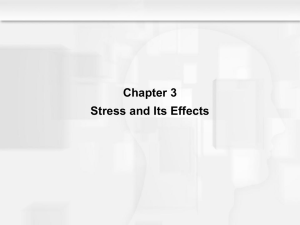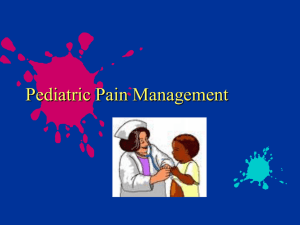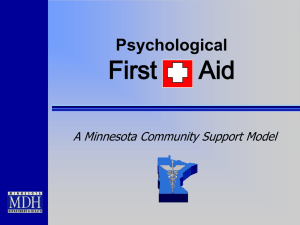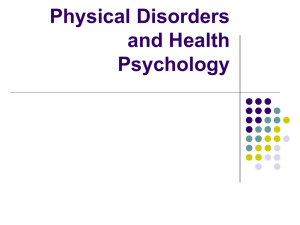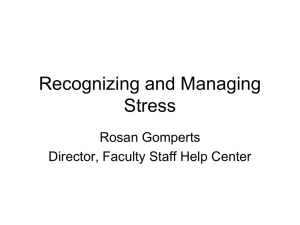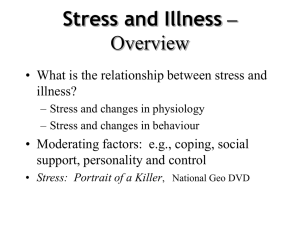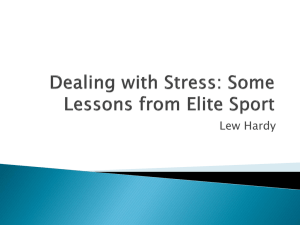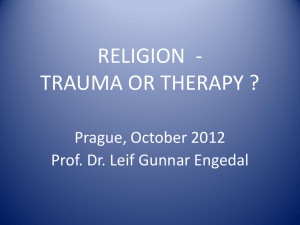Ch 13 Power Point
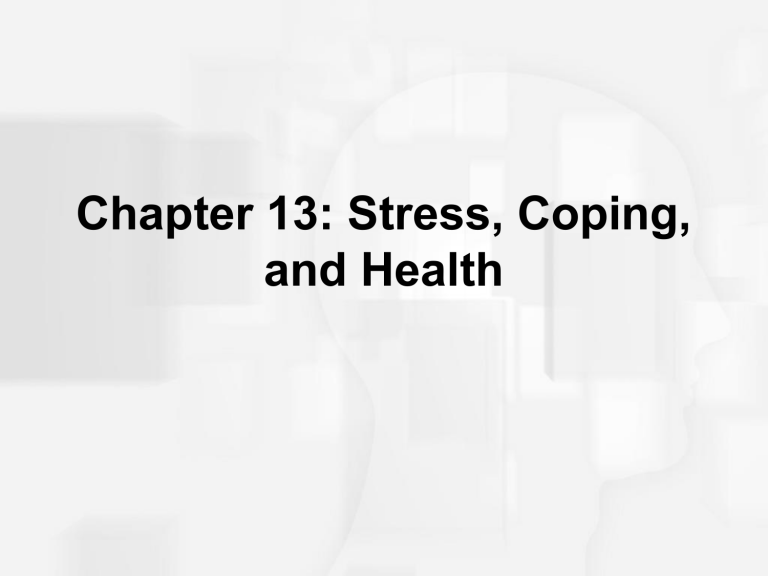
Chapter 13: Stress, Coping, and Health
The Relationship
Between Stress and Disease
• Prior to the 20th century, the principal threats to health were contagious diseases caused by infectious agents: smallpox, diphtheria, etc.
• Nutrition, public hygiene, and medical treatment have obliterated many of these diseases.
• Unfortunately, chronic diseases such as heart disease and cancer, diseases that develop gradually, continue to increase
The Relationship
Between Stress and Disease
– Biopsychosocial model: holds that physical illness is caused by a complex interaction of biological, psychological, and sociocultural factors
– Health psychology: seeks to determine the importance of psychological factors in illness
• Health promotion and maintenance
–Discovery of causation, prevention, and treatment
Figure 13.1 Changing patterns of illness
Stress: An Everyday Event
• Stress is defined in the text as any circumstances that threaten or are perceived to threaten one’s well being and that thereby tax one’s coping ability.
• Major stressors vs. routine hassles
– Cumulative nature of stress: minor stresses like moving, experiencing changes in household responsibilities, etc. can add up to be as stressful as a major traumatic event like a divorce or disaster
– Anxious-neurotic people feel more stress
– The experience of feeling stressed depends largely on cognitive processes;
• People’s appraisals of events are very subjective and influence the effect of the event.
Major Types of Stress
• Acute stressors :
– Threatening events with a clear endpoint and are rather short in duration (speeding ticket)
• Chronic Stress
– Long in duration with no clear endpoint
(neg. boss, mortgage loan)
Major Types of Stress
• Psychologists have outlined 4 principle types of stress
• Frustration : blocked goal
– Very common in every day life
– Ex. traffic jams, waiting for ACT scores or college admittance papers, breaking up
Major Types of Stress
• Conflict : two or more incompatible motivations or behavioral impulses compete for expression (Lewin and Miller)
– Approach-approach: when a person has a choice between 2 attractive goals (least stressful- go on vacation or buy a new TV)
– Approach-avoidance : when a choice must be made about whether to pursue a single goal that has both attractive and unattractive aspects…results in vacillation, or going back and forth (college in new city)
– Avoidance-avoidance: caught b/w a rock and a hard place; choice between 2 unattractive choices
(Most stressful) (back surgery vs. back pain)
Figure 13.2 Types of conflict
Major Types of Stress
• Change : any noticeable alterations in one’s living circumstances that require readjustment ;
– Change events seen as ‘positive’ can produce as much stress as negative
– Social Readjustment Rating Scale: Holmes and Rahe (1967)
• measure life change as a form of stress, giving higher points (life change units) for more stressful events
• Does not measure change exclusively
• Focuses on neg. events
Major Types of Stress
• Pressure
– expectations or demands that one behave in a certain way
– pressure to perform or to comply
• Weiten Developed a Pressure Index with a higher correlation than the SRRS to psychological problems associated with stress
Responding to Stress Emotionally
• Stress responses are multidimensional, including emotional, psychological, and behavioral realms.
• Emotional Responses
– Annoyance, anger, rage
– Apprehension, anxiety, fear
– Dejection, sadness, grief
– Positive emotions: promoting creativity and flexibility in problem solving, facilitating the processing of important information about oneself, and reducing the adverse physiological effects of stress.
Responding to Stress Emotionally
• Emotional response and performance
– The inverted-U-hypothesis:
• The higher the difficulty a task is, lower levels of emotional arousal are needed
• More simple tasks require a higher level of emotional arousal
Figure 13.5 Arousal and performance
Stress and Positive Emotions?
• Do positive emotions disappear during times of great stress?
– No, often times they increase (9/11 example)
– Moreover, the more positive emotions you are able to exhibit, the greater resilience to stress
Responding to Stress Physiologically
• Physiological Responses
– Fight-or-flight response: Walter Cannon (1932).
• The FF response is a physiological reaction to threat in which the autonomic nervous system
(ANS) mobilizes the organism for attacking
( fight ) or fleeing ( flight ) an enemy
• modern stressors are more long term (the checkbook)
– Higher physiological reactions include: higher consumption of oxygen, higher blood pressure, dilated pupils, reduction in digestive processes
Responding to Stress Physiologically
– Selye’s General Adaptation Syndrome: theory about how stress reactions occur
• Alarm: an organism recognizes a threat and mobilizes resources – essentially enters the FF response
• Resistance: physiological arousal stabilizes but is still above baseline, as the organism copes with the stressor
• Exhaustion: the body’s resources are depleted…Selye believed that this is where diseases of adaptation come in.
Responding to Stress Physiologically
• Stress and the Brain
– Primary Path: Stress causes the hypothalamus to activate the sympathetic part of the ANS (main part are the adrenal glands which release catecholamine to cause the F-F response)
– Secondary Path: the hypothalamus causes the pituitary gland to activate the adrenal glands which secrete corticosteroids to increase energy and reduce inflammation
Responding to Stress Behaviorally
• Behavioral Responses
– Frustration-aggression hypothesis : striking out at others aggressively,usually the result of frustration…(Dollard)
– Catharsis: purging of emotions (venting), aggressive behavior leads to more aggression
– defense mechanisms
• Coping: refers to active efforts to master, reduce, or tolerate the demands created by stress (can be positive or negative)
Responding to Stress Behaviorally
• Coping Mech:
– Giving up on oneself: passively accepting setbacks that might be dealt with effectively
• learned helplessness – passive behavior produced by exposure to unavoidable aversive events
• Blaming oneself: perpetuates negative reactions and behaviors toward stress
• Neg. self-talk can lead to depression
Responding to Stress Behaviorally
• Coping Mech:
– self-indulgent (eating, drinking, smoking, shopping, internet, pornography)
• Trying to solve problems by immersing yourself in sub. forms of satisfaction
– defensive coping (erecting defense mechanisms)
• Denial of Reality, Fantasy, isolation,
Undoing, Overcompensation
• Use the principle of self-deception
Responding to Stress Behaviorally
• Coping Mech:
– constructive coping
• confronting problems directly
• realistically appraising situations
• recognize and inhibit disruptive emotional responses
• ensuring your body is not especially vulnerable to stress
Figure 13.4 Overview of the stress process
Effects of Stress:
Behavioral and Psychological
• Roy Baumeister’s work shows that people under pressure to perform may feel selfconscious, which leads to disruption of attention and “ choking ” under pressure
– Impaired task performance
– Burnout: physical, mental, and emotional exhaustion that is attributable to long-term involvement in emotionally demanding situations…loss of meaning.
Figure 13.7 The antecedents, components, and consequences of burnout
Effects of Stress:
Behavioral and Psychological
• Keinan (1987) also did stress studies
– He found that stress disrupts peoples ability to focus attention
– They jump to decisions too quickly
– Unsystematically review options
– Basically, it is harder for people to suppress competing thoughts
Effects of Stress:
Behavioral and Psychological
• Psychological problems and disorders: from sleep problems and unhappiness, to full-fledged psychological disorders such as schizophrenia and depression
• Positive effects:
– stress can promote personal growth or selfimprovement, forcing people to develop new skills, reevaluate priorities, learn new insights, and acquire new strengths.
– Conquering a stressful challenge may also lead to improved coping abilities and increases in selfesteem.
– What school of psyc?
Effects of Stress: Physical
• Psychosomatic diseases: physical ailments with a genuine organic basis that are caused in part by psychological factors, especially emotional distress
– hypertension, ulcers, asthma, eczema, and migraine headaches
– Heart disease accounts for nearly one-third of the deaths in the U.S. each year
– Atherosclerosis, or gradual narrowing of the coronary arteries, is the principle cause of CHD
Effects of Stress: Physical
• Heart disease
– Type A behavior - 3 elements
• strong competitiveness
• impatience and time urgency
• anger and hostility (most important)
– Type B Behaviors (less likely)
• Relaxed
• Patient
• Easy going
• Amicable behavior
• One study found that patients with high hostility ratings are twice as likely to develop Atherosclerosis
Figure 13.9 Anger and coronary risk
Effects of Stress: Physical
• Stress and immune functioning
– Emotional reactions can trigger cardiac symptoms in patients with stable coronary disease.
– Depressive disorders may also be a risk factor for heart disease, with some studies showing that the risk of CHD is doubled with depression
– Stress has also been shown to decrease the immune response, the body’s defensive reaction to invasion by bacteria, viral agents, or other foreign substances…decreasing white blood cells called lymphocytes
Featured Study
• Used a longitudinal study (over 4 years)
– Does depression increase the risk of cardiac mortality?
• Minor depression: 60% increase in heart disease
• Major depression tripled the risk of cardiac death
–Recent studies have found depression doubles the chance of heart disease and changes how it develops
Table 13.4 Health Problems that may be Linked to Stress
Figure 13.11 The stress-illness correlation
Factors Moderating the Impact of Stress
• Social support
– Increased immune functioning
– decrease the negative impact of stress
• Optimism
– More adaptive and more effective coping
• Pessimistic explanatory style
– related to passive coping and poor health practices.
Factors Moderating the Impact of Stress
• Conscientiousness
– Fostering better health habits
– related to increased longevity, possibly because being conscientious leads better preventive medicine
• Autonomic reactivity (physiological factors)
– Cardiovascular reactivity to stress
– appear to play a role in how significant the impact of stress is on an individual.
Figure 13.12 The prevalence of smoking in the United States
Health-Impairing Behaviors
• Smoking
– A 25 year old male who smokes two packs a day has an estimated life expectancy 13-14 years shorter than that of a similar, nonsmoker.
– Health risks decline quickly for those who give up smoking, but quitting is difficult and relapse rates are high.
• Poor nutrition
– linked to heart disease, hypertension, and cancer, among other things
• Lack of exercise (same as poor nutrition)
Figure 13.13 Quitting smoking and cancer risk
Health-Impairing Behaviors
• Alcohol and drug use
– carry the immediate risk of overdose and the longterm risk of many diseases
• Risky sexual behavior
• Transmission, misconceptions, and prevention of
AIDS
– HIV is transmitted through person-to-person contact involving the exchange of bodily fluids, primarily semen and blood
– Many young heterosexuals downplay their risk for
HIV, causing them not to adopt the behavioral practices that minimize risk.
Development of Health-Impairing
Behavior
• 1) Health-Impairing Behaviors creep up slowly
• 2) Many Health-Impairing Behaviors are quite pleasurable
• 3) Most risks associated with Health-
Impairing Behaviors are a long way off
• 4) People underestimate how these behaviors will affect them and overestimate their effect on others
Reactions to Illness
• Many reactions to illness are not conducive to health
– Seeking treatment
• Ignoring physical symptoms
– Communication with health care providers
• Barriers to effective communication
– Following medical advice
• Noncompliance with medical advice is a serious issue.
• Noncompliance is more likely if instructions are hard to understand, when they are difficult to follow, and when patients are unhappy with their doctor
Figure 13.16 Biopsychosocial factors in health
